13 Types Of RED BIRDS In Virginia (ID Guide With Photos)
Did you recently come across a red bird in Virginia, and want to know what species it was?
Identifying red-colored birds in Virginia is not as easy as it might seem, since there are many bird species in the Old Dominion State that are either completely red or partially red.
To help you identify the bird you saw, we’ll cover all the different red birds of Virginia.
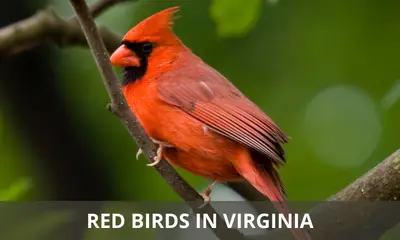
What are the types of red birds in Virginia?
The 13 types of red-colored birds found in Virginia are:
- Northern Cardinal
- House Finch
- Scarlet Tanager
- Summer Tanager
- Red-headed Woodpecker
- Red-bellied Woodpecker
- Purple Finch
- Painted Bunting
- Rose-breasted Grosbeak
- Common Redpoll
- Red Crossbill
- White-winged Crossbill
Some of these red birds are found year-round in Virginia, while others are winter visitors and yet others are summer visitors (more on that below).
Now let’s dive into the details, and take a closer look at each of these red birds in order to get the full scoop:
Northern Cardinal
Scientific name: Cardinalis cardinalis
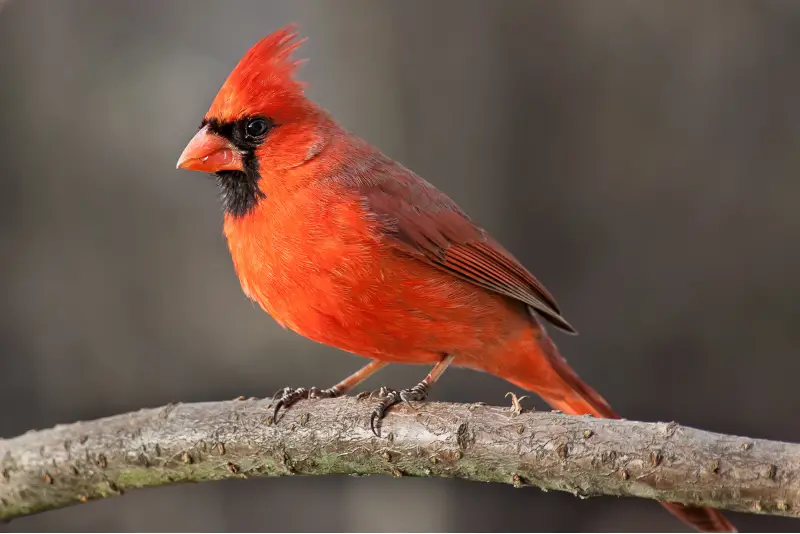
As the state bird of Virginia, the Northern Cardinal is the most well known red bird of Virginia.
Male Northern Cardinals have a bright crimson coloration on their crested head, chest, and belly, and slightly darker plumage on their back and wing feathers.
In addition, the face has a black mask extending from the brightly colored bill to the throat.
Female Northern Cardinals are not quite as colorful as males, and have a more buff-brown body color.
The Northern Cardinal is a common bird of Virginia, and can be seen year round in backyards, gardens, small forests, and parks.
During the winter months it doesn’t defend its territory, and sometimes gathers in flocks of up to 25 individuals that feed together. This red bird is a regular visitor at bird feeders.
House Finch
Scientific name: Haemorhous mexicanus
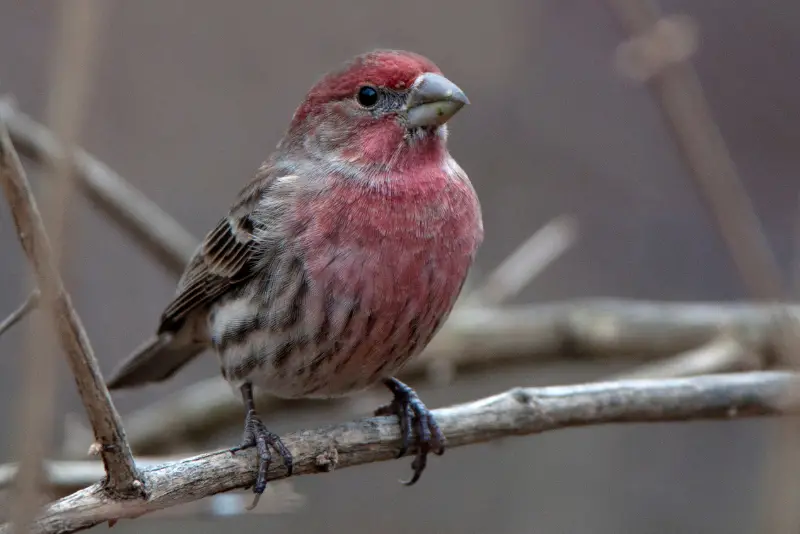
The House Finch is one of the most common red birds in North America, and is mostly found in settled areas, ranging from small towns to large metropolitan centers.
Adult male House Finches can be identified by the bright red plumage on the head and upper breast, although in some cases they are slightly more orange or yellowish in color.
Unlike the males, the females are not red birds, but instead have grayish streaks on a brown background.
The House Finch was originally a western bird, and it wasn’t until the 1940s that this red bird was discovered in New York and other places on the east coast of the US.
The eastern House Finch population began to grow in the 1950s and 60s, and by the year 2000, it had expanded so far west that it connected with the original western population.
The House Finch is entirely herbivorous, and forages on seeds (such as thistle seeds), buds, and fruits.
If you set up a bird feeder in your backyard, you can expect these red birds to be among the first to visit it, especially if you offer black oil sunflower seeds, nyjer seeds, or suet.
This red bird is not migratory, and is found in Virginia all year round. However, it does move to areas with more food outside of the breeding season.
Scarlet Tanager
Scientific name: Piranga olivacea
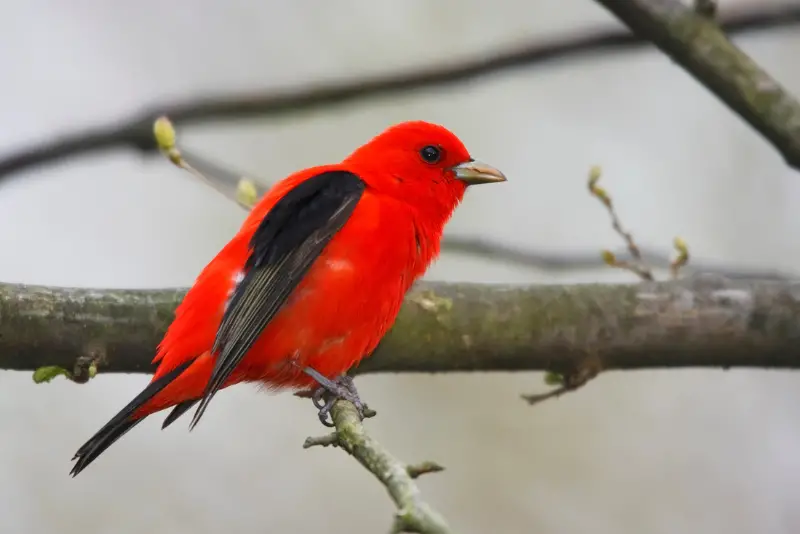
The Scarlet Tanager is a bird with a tropical appearance, due to the bright scarlet plumage of the males, which contrasts with their coal-black wings and tail feathers.
Both sexes sing a similar song in order to mark and defend their territory from other Tanagers.
But unlike the startling bright red color of the male, the female looks more like a pale yellow Virginia bird.
This brilliant red bird loves warm temperatures, and thus arrives late in spring, and leaves early in fall. During spring and fall, Scarlet Tanagers from Canada can be seen passing through the state.
While there are many Tanager species in the world, most of these are tropical, and the Scarlet Tanager is the only tanager that breeds in Virginia (as the Summer Tanager is a very rare summer visitor in southern Virginia).
These birds are insectivores, and feed on spiders and flying insects (including bees and wasps) high up in tree canopies.
This red bird is a summer visitor to Virginia, and spends its winter in Central and South America.
In late summer, they are also partial to berries, such as blackberries, strawberries, raspberries, juneberries and mulberries, and having these plants in your garden is a great way to attract them.
Summer Tanager
Scientific name: Piranga rubra
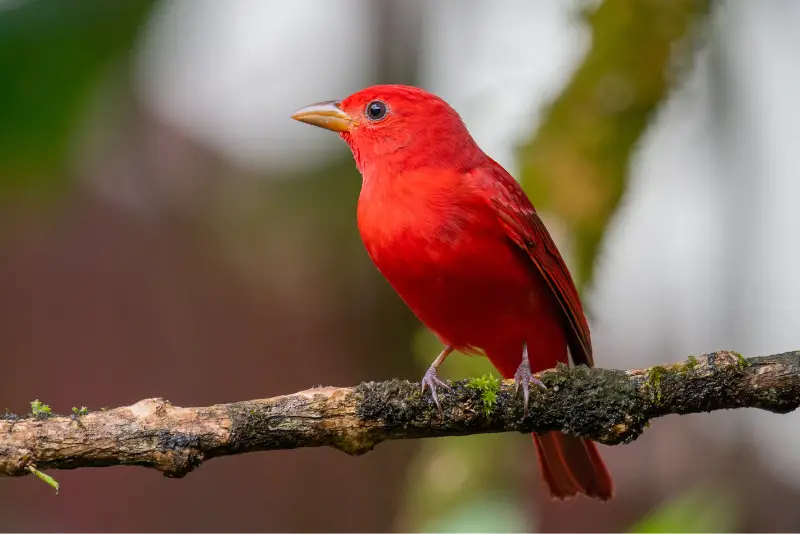
The Summer Tanager is a beautiful and alluring songbird of Virginia with a peaked crown.
Adult male Summer Tanagers are entirely bright red, although they have slightly darker red feathers on their wings.
It can be hard to observe Summer Tanagers, since they like to forage high in the treetops of deciduous and mixed forests.
In contrast to males, females and immatures are buff yellow, although they sometimes have a few patches of orange.
The Summer Tanager is a summer visitor and breeding species in Virginia, and can be seen here from May through August.
While there are many tanager species in the world, most of these are tropical, and the Summer Tanager is one of two tanager species that breed in Virginia.
This red bird is strictly migratory, and leaves Virginia in the fall to spends the cold season in Mexico and Central America
Red-headed Woodpecker
Scientific name: Melanerpes erythrocephalus
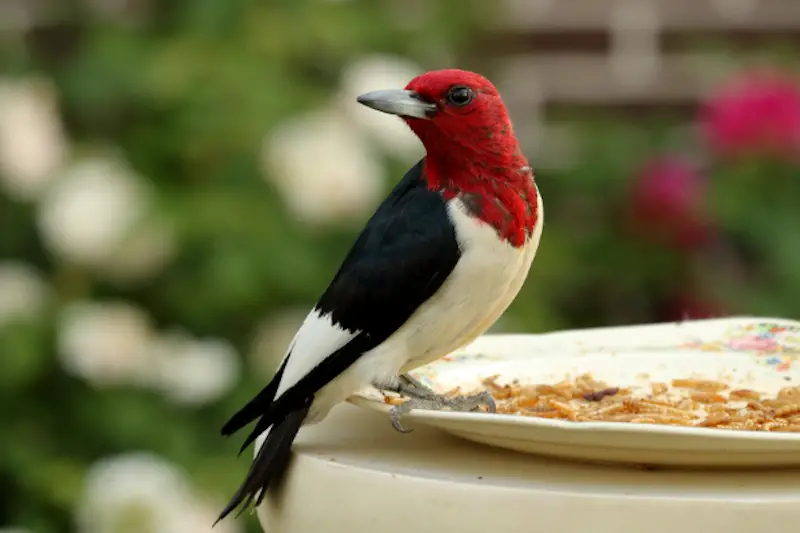
The Red-headed Woodpecker is one of the few non-dimorphic woodpeckers, which means that males and females look alike.
Red-headed Woodpeckers have an all-red head with a solid black back. They also have a white chest, rump and belly, as well as black wings and a black tail. The bill and legs are gray.
In Virginia, no other woodpecker has an all red head. The Pileated Woodpecker has a head that is mostly black.
The Red Headed Woodpecker favors wide-open deciduous or coniferous forest habitats, or forests with plenty of dead or rotten limbs.
It may use the same nest cavity for multiple years in a succession, in contrast to other woodpeckers that only use them once or for a small period of time.
This woodpecker used to be common in Virginia, but the population has unfortunately declined by more than 90 percent, and the Red-headed Woodpecker is now a rare sight in the Old Dominion State.
Red-bellied Woodpecker
Scientific name: Melanerpes carolinus
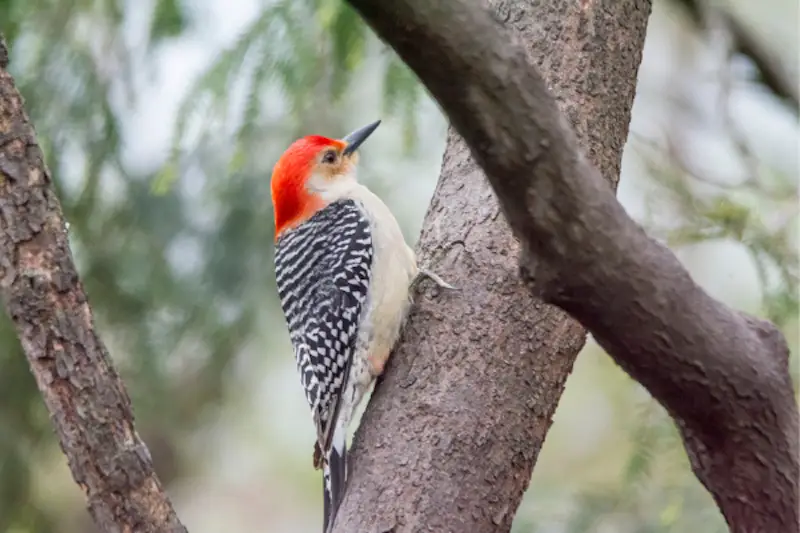
The Red-bellied Woodpecker has a black-and-white “Zebra” pattern on its back, as well as a white rump.
Its red crown goes all the way down to the base of the neck. Both sexes look similar, although the female has a partially gray crown.
The Red Bellied Woodpecker favors shady woodlands, forest edges and backyards with old trees.
It excavates holes in rotting wood to locate beetles, centipedes, spiders, and other creatures.
During winter, this mostly red bird stores berries and acorns in tree crevices and cracks.
Every year, the Red-bellied Woodpecker excavates a new nest below the previous one in the same tree.
While it is named for the rufous tinge on its belly, this can be hard to see unless you get a close up view.
Fortunately, this beautiful bird is steadily expanding its range across the whole country.
Purple Finch
Scientific name: Haemorhous purpureus

The Purple Finch is a little songbird with a compact body, a conical beak, and a head that is disproportionately larger than its body.
The heads and breasts of adult males are a deep shade of raspberry red, while the backs of their bodies are streaked with red and brown feathers. The flanks are cream colored with pink streaks.
Birds from the eastern part of the range have a white belly, whereas birds from the western part of the range have a gray belly. Purple Finches in Virginia have a gray belly.
The upperparts of females and immature birds are streaked with a grayish brown, while the underparts are a light cream color with brown streaks.
During the months of May through August, the Purple Finch is found breeding in northern parts of North America, and does not occur in Virginia.
During the winter, however, these birds migrate south and spend the cold months in the eastern United States. At this time they can be seen all over Virginia.
Painted Bunting
Scientific name: Passerina ciris
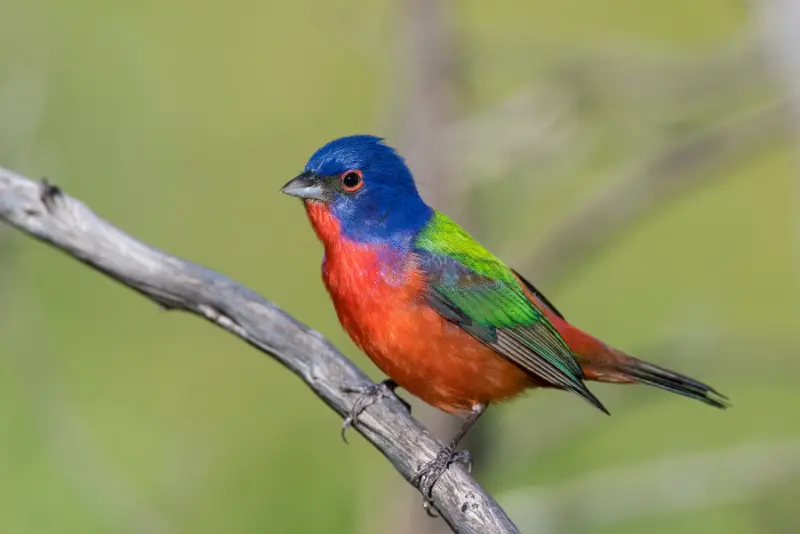
The Painted Bunting is a beautiful small songbird with a very colorful plumage.
Adult males have a bright red chest, throat, belly, and rump, contrasting with a dark blue hood. Their backs and the wings are yellowish green.
Females and immature birds are pale green on top, with buff yellow underparts.
During the months of May through September, the Painted Bunting may be encountered breeding along the coast of Virginia.
It is a migratory bird, with most individuals wintering in Central America. Its preferred habitat are clearings and margins of dense forests in areas close to water.
The secretive nature of the Painted Bunting makes it hard to observe, notwithstanding the bright colors of the male.
Similar to other buntings, it mostly eats seeds, except for the breeding season, when insects form an important part of its diet.
You can attract this red bird to your bird feeder with sunflower seeds or millet.
Rose-breasted Grosbeak
Scientific name: Pheucticus ludovicianus
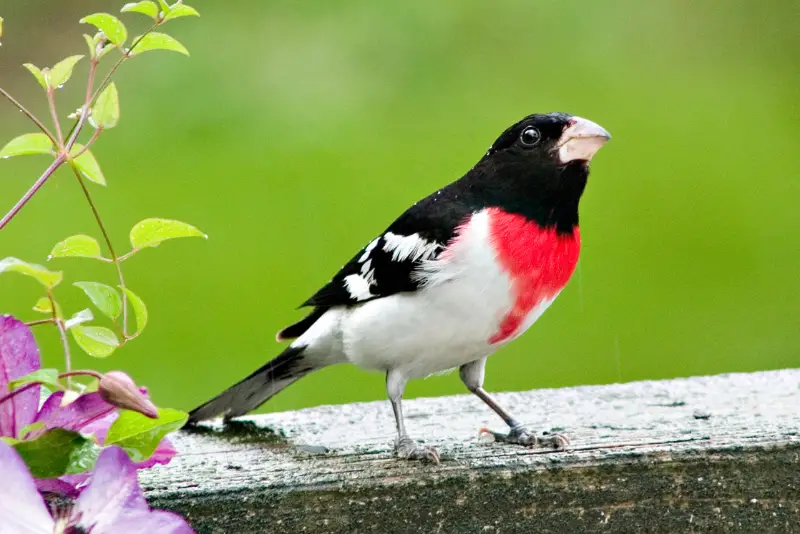
The Rose-breasted Grosbeak is easily identifiable due to its distinct markings and its large beak.
During the summer, adult males have a scarlet red breast, which contrasts with their jet black hood and back. Their black wings have white patches and white wing bars.
Adult females and immature birds, on the other hand, have streaked brown plumage that is lighter on the underside than on the back. They also have a white eyebrow stripe and white wingbar.
Rose-breasted Grosbeaks are summer visitors in Virginia from May through August.
This red songbird is migratory, and flies to Central America to spend the winter months. Similar to other crossbill species, it specializes in feeding on the seeds of conifer cones.
Common Redpoll
Scientific name: Acanthis flammea
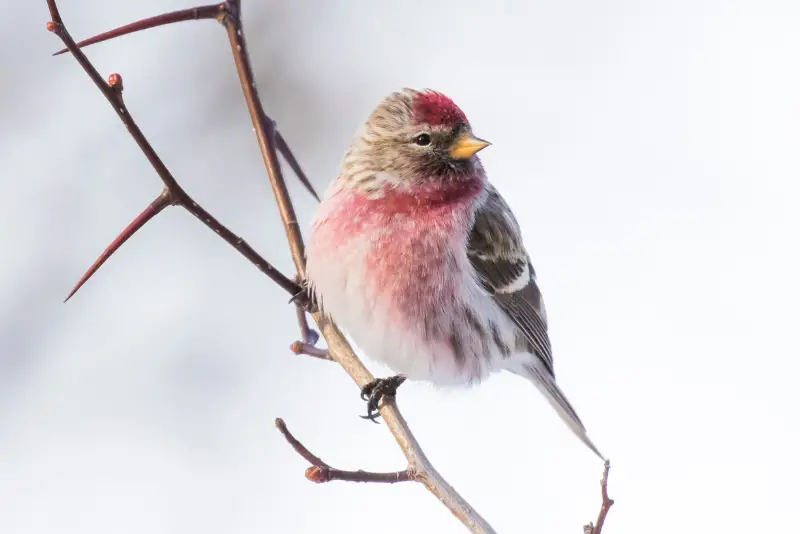
The Common Redpoll is a small finch of northern forests. It is a breeding bird throughout Canada, and is an irregular winter visitor in northern Virginia during irruptive years.
Adult males have a gray-brown head with a red forehead, as well as a pinkish red breast and flanks.
Female Common Redpolls are less colorful, but they also have a red forehead. Both sexes have brown-gray upperparts with dark streaks.
This red-colored bird in Virginia favors boreal forests all the way north to the arctic.
Outside of the breeding season it forms small flocks that move around in search of areas with plentiful seeds.
Red Crossbill
Scientific name: Loxia curvirostra
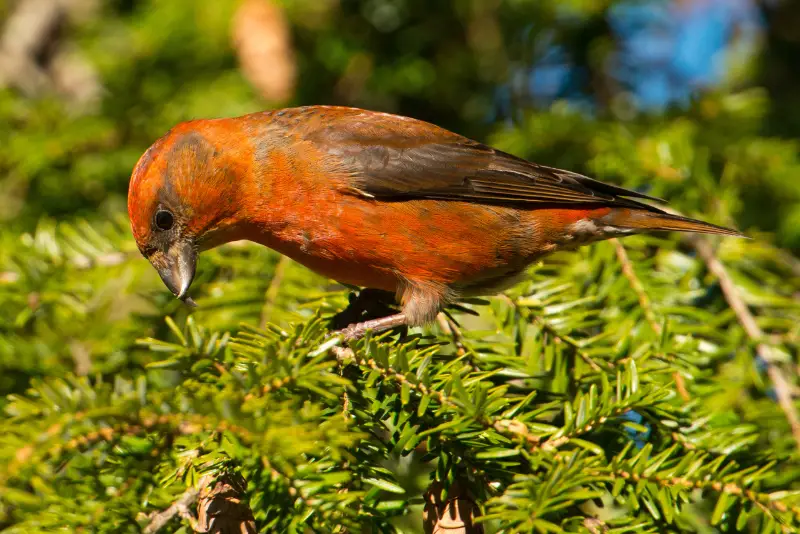
These birds get their name from their distinctive bills, which resemble a bent pair of scissors with their points crossed.
Adult males of this red bird have a deep red underside, head, and rump, while their wings and back are dark brown
Females and immature Red Crossbills are more inconspicuous, and are olive-colored with reddish streaks on their flanks and belly.
Red crossbills are able to harvest seeds from pine cones by cutting through the scales of the cones with their crossbill.
They will use their feet to keep the cones pinned down while they use their tongues to pick the seeds out of the cones and then eat them.
These red birds breed in Canada and northern parts of the USA, and only show up as scarce winter visitors in Virginia.
The breeding season of these crossbills is timed to coincide with ripening of pine or spruce cones, and can sometimes start as early as February.
White-winged Crossbill (Two-barred Crossbill)
Scientific name: Loxia leucoptera
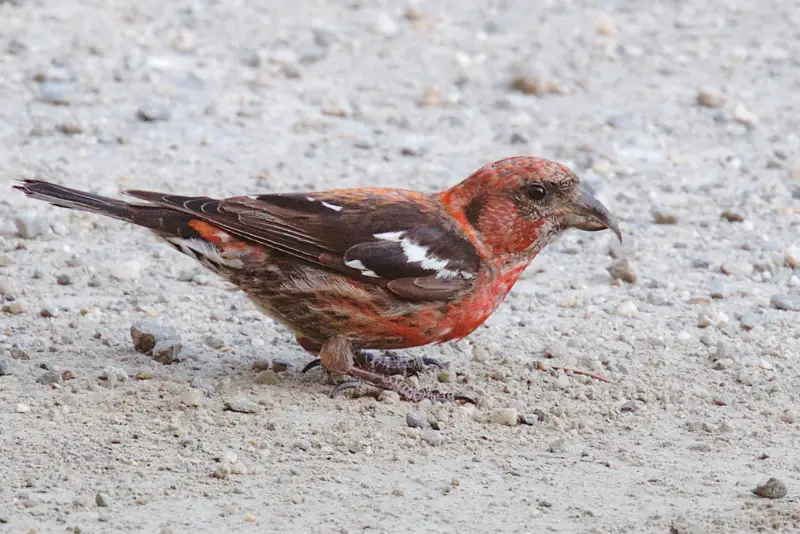
Similar to other crossbills, the White-winged Crossbill has a cross-tipped beak.
Most of the body plumage of adult male White-winged Crossbills is pinkish red, although it is paler compared to the color of Red Crossbill males.
The black wings have two white wing bars that are prominently visible (explaining the name of this crossbill).
The body of females is streaked with a yellowish color, but their wings are black with a wingbar pattern similar to that of males.
White-winged Crossbills are largely non-migratory, and remain in the breeding range in Canada and northern and western states of the US all year round.
In Virginia, White-winged Crossbills are seen as scarce winter vagrants that are more abundant in some years.
What are the types of red headed birds in Virginia?
There 4 types of red headed birds in Virginia are:
- House Finch
- Red-headed Woodpecker
- Scarlet Tanager
- Red-bellied Woodpecker
The most common bird with a red head in Virginia is the House Finch. But keep in mind that only males have a red head, while females are largely brown-streaked birds.
The most stunning red headed bird in Virginia is the Red-headed Woodpecker, but unfortunately these woodpeckers have become quite rare over the past decades.
What are the types of red and black birds in Virginia?
The 3 types of red and black birds in Virginia are:
- Scarlet Tanager
- Red-winged Blackbird
- Northern Cardinal
Red-winged Blackbirds are the most common red and black birds in Virginia. Males are almost entirely black, except for a patch of bright red on their shoulders.
Conversely, male Northern Cardinals are almost entirely red-colored birds, except for their black face.
Scarlet Tanagers have a bright red body and head, while their wings and tail are jet black. If you’re not sure which one of these you saw, check out our ID guide with photos above.
Final remarks
This concludes our article on the types of red songbirds found in Virginia.
If you’ve spotted one of these red birds while bird watching in your backyard, hopefully this ID guide will help you identify it quickly and easily.
And if you enjoyed this article, check out our guide to the large birds of Virginia.
